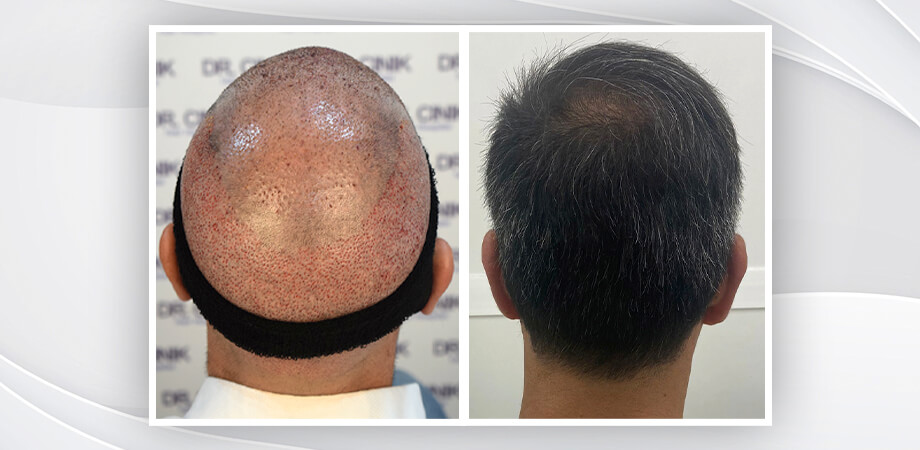Hair Transplant Scars

Sommaire
There have been significant advancements in hair transplants, with most procedures becoming less invasive and less painful. And with the introduction of needle-free anesthesia, the procedures are made even more comfortable.
However, there’s one thing that’s been concerning to most people seeking hair transplant surgery – the inevitable scarring most widely present in the donor area.
So, let’s take a closer look at hair transplant scars, and see whether they should concern you.
Most Common Hair Transplant Procedures
Hair transplant surgery is the first thing that we need to examine, to understand more about transplant scars. After all, different types of surgery are performed differently, and scarring will depend entirely on the procedure.
There are four most common transplant procedures:
- Follicular Unit Transplantation (FUT)
- Follicular Unit Extraction (FUE)
- Sapphire Follicular Unit Extraction (FUE Sapphire)
- Direct Hair Implant (DHI)
FUT
FUT is one of the most invasive hair transplant procedures. For the Follicular Unit Transplantation FUT, the donor site (typically on the back of the scalp) is removed in the form of a strip, which is later separated into dozens of individual grafts. It’s not surprising that there’s another name for this type of surgery for hair growth, strip surgery.
The donor area is then sutured together, and the stitches are typically removed after approximately ten days. Patients will be left with a linear scar that might go from ear to ear, depending on the donor area’s size.
After the FUT procedure, the recipient site might take a while to heal, but won’t have any noticeable scars.
FUE
While FUT could leave a noticeable scar, the FUE method is much cleaner and should leave no apparent marks on the scalp – which is why it’s the most popular procedure. During follicular unit extraction FUE, hair follicles are extracted and inserted individually.
The procedure goes as follows: after shaving donor areas, the surgeon removes individual hair follicles. Small incisions are made in the recipient site where the hair follicles will be placed one at a time. This minimizes scarring and ensures a completely natural look.
So, due to the lack of scarring in the donor, FUE hair transplantation is a much more popular procedure than FUT.
SAPPHIRE FUE
This procedure is very similar to the original FUE hair transplant. The only difference is in the tools used. For Sapphire FUE, the surgeon will use a scalpel made of sapphire with a V-shaped blade. The shape reduces scarring even further and allows for the incisions in the recipient area to be even more precise.
DHI
Finally, DHI is another procedure similar to FUE. For DHI, a special Choi implantation pen is used. The pen has a hollow needle where individual hair follicles are loaded. The needle then makes the incision in the recipient site and implants the hair follicle simultaneously. Scarring is minimized, often not even visible to the naked eye.
Covering Scars With A Second Hair Transplant
Covering hair transplant scars with a second hair transplant is only possible with the FUE procedure. In case you’ve had a FUT procedure done and want to cover the scar in the donor area, you could opt for an FUE. However, it might not always be successful; it depends on the size of the scar and its thickness.
Keep in mind that scar tissue is different from normal tissue and might not accept implanted hair follicles well. With transplantation to the scar tissue, hair loss in the area could occur after a while.
To cover the scars from the hair transplant, you could also opt for scalp micro-pigmentation. It’s mostly similar to tattooing the scalp to make it appear as if there’s hair there. When it comes to the recovery time, scalp micro-pigmentation heals fast and leaves no additional scars.
How To Ensure Minimal Scarring
To keep hair transplant scarring to the minimum, it’s always crucial to follow your doctor’s advice. Your doctor will tell you precisely what you should do post-op.
You’ll need to avoid staying in direct sunlight for a few weeks after the surgery – scars tend to become more noticeable after being exposed to the sun.
Don’t wear hats, and try to keep your scalp cool until you’ve completely healed from the transplant surgery. Sweat and unsterilized materials could cause an infection that can increase the visibility of scars.
And finally, if you want to have your scars barely noticeable after a hair transplant, it’s crucial to schedule your procedure with a reputable clinic.
Hair Transplantation With Dr. Emrah Cinik
Dr. Emrah Cinik and his team have years of experience with hair transplant surgery and are highly regarded by patients and medical authorities.
Dr. Emrah specializes in FUE hair transplants, which minimize scarring and leave the scalp looking natural and full of hair. If you want to schedule a consultation, contact Dr. Cinik Hair Hospital and breathe new life into your hair.
CONCLUSION
Hair transplant scars should be nothing to worry about if experienced professionals do your transplant procedure. While some scarring is imminent regardless of the type of surgery you opt for, it can be easily covered once your hair starts growing again.



